Glaucous-winged Gull Larus glaucescens and possible hybrids
Text and Images © Nial Moores March 2005, Edited by Charlie Moores
Introduction
Restricted as a regular breeding and wintering species to a rather narrow geographical range (coastal Far East Asia), the Slaty-backed Gull Larus schistisagus is a fairly numerous non-breeding visitor to coastal South Korea. Although adults are usually straightforward to identify (through for example a combination of structure, leg colour, upperparts' coloration and primary patterning) juvenile and immature plumages can prove considerably more challenging – all the more so due to enormous individual variation caused by bleaching, wear and moult. This note aims therefore to summarise a few key identification features especially for immature plumages of Slaty-backed Gull, with special reference to the separation of Juveniles and First-winters from the locally much scarcer Glaucous-winged Gull Larus glaucescens. It also suggests some possible features that might (or might not) be useful in identifying birds of hybrid origin. The note is based on 15 years of personal gull-observation in South Korea and Japan (from Kyushu north to Hokkaido), with additional single extralimital observations by the author of Slaty-backed Gull in Canada and Hong Kong. Observations have been made in all months, though largely between October and March. Considering the recent upsurge of interest and knowledge in Asian gulls, especially following the publication of Malling Olsen and Larsson (2003), Birds Korea would very much welcome input and opinions from experienced observers to help improve the quality of this note.
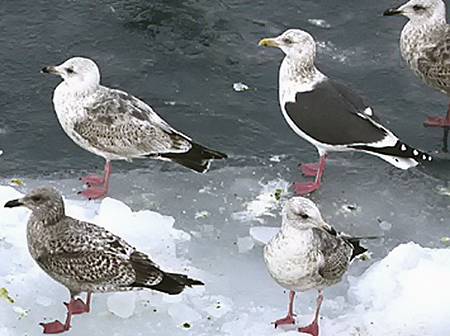
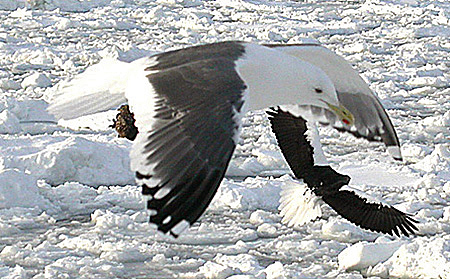
This is a typical northeast Asian gull of rocky coasts, harbors and pack-ice edge, most easily identified in flight by its distinctive “string of pearls”.
Status and Distribution in South Korea
The Slaty-backed Gull is a fairly numerous non-breeding visitor to South Korea, with maximum numbers occurring in winter to early spring (December-March) when concentrations of several hundred individuals can be found, most especially on rocky islands and harbors along the east coast. The highest day count known to Birds Korea is ca 800+ recorded near Daebo, Guryongpo, on March 9th, 2005 (NM, Werner Suter et al). Rather smaller numbers can also be found in harbors and on rocky islands on the south and west coasts, with a very few over-summering in key gulling areas (e.g., the Geum estuary). No Slaty-backed Gulls have yet been seen away from the coast or open sea areas by the author, clearly indicating that it is very strongly a marine-preferential species (it seems especially interesting in this regard that several extralimital claims of the species have apparently been from inland continental areas of North America).
Structure
Although there is often great variation in structure between individuals of a gull species (with larger and smaller, longer-billed and shorter-billed birds etc), structural tendencies are of course very useful in supporting the identification process. In this way the vast majority of Slaty-backeds are structurally reasonably distinctive. At rest most appear stout, a little pot- or barrel-bodied and quite powerful-headed, typically lacking the long forehead found in many Glaucous-winged. Additionally, many are often relatively short-billed compared to either Glaucous-winged or Glaucous Gull Larus hyperboreus, similar to or sometimes even shorter-billed than many Vega Gull Larus vegae. Typically, the bill appears quite deep at the base; lacks the obvious thickening along the length seen in many Glaucous-wingeds; has only a moderate gonydeal angle; and has a fairly blunt-looking tip (not obviously parallel-sided, hooked or drooping like some Mongolian Gull Larus mongolicus). The gape line often appears rather obvious, drooping sharply to the rear (adding to the species' “disapproving mien”). Typically Slaty-backeds also show at rest only a fairly short primary projection beyond the tail, and a moderate tertial step. Most noticeably their legs typically appear short, rather thick, and set well apart (presumably an adaptation to roosting on exposed and wind-swept rocks, the resultant low center of gravity has provoked comparisons with both Red-breasted Goose Branta ruficollis, low-set in among flocks of grey geese, and more entertainingly, to sumo wrestlers!). The posture is often kept rather hunched, but by contrast, alert birds appear rather long-necked and often strikingly pot-bellied.
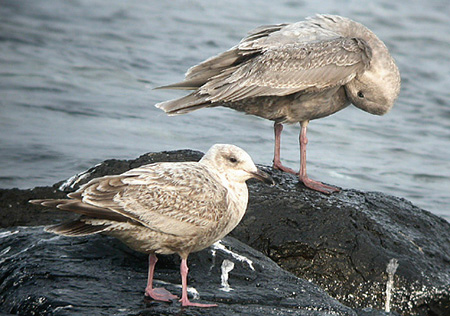
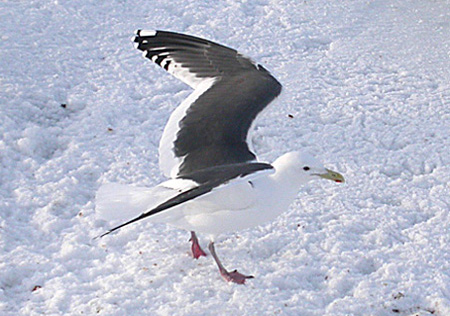
With pink legs, very dark upperpart coloration and distinctive upperwing and underwing pattern, older immatures and adults are rather straightforward to identify.
In flight, Slaty-backeds tend to look rather heavy-bodied, relatively short-winged (especially when compared to some Mongolian Gull), and fairly blunt in the hand.
Identification: Second-winter/Adults
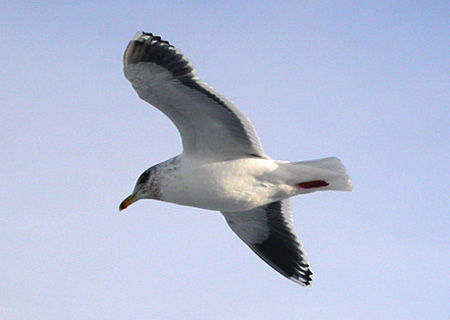
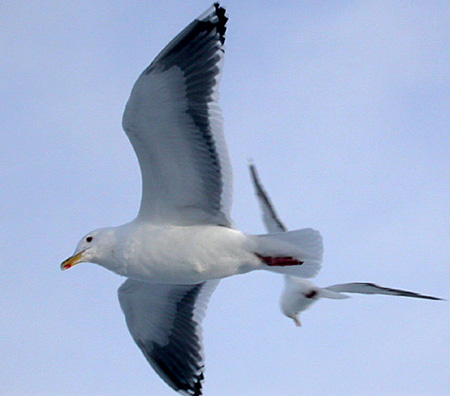
Note the very distinctive underwing pattern, obvious at different angles.
Based on structure (as above), bare parts colour (including pale eyes from about Second-summer and deep pink legs at most ages) and plumage, the vast majority of individuals from approximately Second-winter onwards are rather straightforward to identify. At rest, they are the only large, very dark-mantled gull in the region with bright bubble-gum pink legs. With the exception of hybrid types (see below) or extralimital species, confusion of birds from Third-winter onwards especially is only really possible with occasional very dark-mantled Vega Gull Larus vegae and occasional bulky taimyrensis gulls. Vega Gulls, however, typically show a significantly different structure to Slaty-backed (being often even more ill-propor- tioned, longish-billed, weak-chested, with often drooping wings) and the majority show some dark peppering in the eye or are purely dark-eyed, whereas all (or very nearly all) adult-type Slaty-backed are very pale-eyed. In flight, Vega typically show an obviously different primary pattern, with only a minority showing a weak “string of pearls” effect, similar to that cited for Slaty-backeds (though see the discussion on hybridization below).
Taimyrensis gulls tend at rest also to look structurally quite different from Slaty-backed: typically rather small- and round-headed, neatly-proportioned, with a fairly long primary projection beyond the tail. Additionally, many show at least some yellowish tones to either the legs or the webbing of the feet, while the vast majority of older taimyrensis appear rather paler grey in the saddle than typical adult Slaty-backed - and of course show a very different upperwing and underwing pattern (see "The Herring Gull Assemblage" in South Korea for more detailed notes and images of both of these taxa).
As often noted, Slaty-backed Gull is considered easiest to identify confidently in flight. In good light conditions, the underwing shows a very clean and distinctive pattern, with pure white underwing coverts and a broad white trailing edge, both contrasting with dark grey bases to the underside of the primaries and outermost secondaries, in turn setting off a row of black primaries, tipped white, with an extra line of translucent pale spots (the “string of pearls”) crossing the grey. The upperwing is very dark slate-grey, with a rather broad and striking white trail (broadest on the secondaries), and black in the outer primaries. The extent of black in the outer primaries is apparently a little variable, as is the prominence/presence of white mirrors in the outer primaries, p 10 (invariable) and p 9 (often reduced; sometimes appearing absent). The “string of pearls” (the most often used identification feature for flying birds) is formed by an extra line of white markings, somewhat separating the slate-grey from the black of the distal part of the outer primaries, often prominent on primaries 5, 6 and 7 (and sometimes 8). For a more detailed description of this distinctive wing pattern, please refer to Malling Olsen and Larsson (2003).
Juveniles and First-winters
Juveniles and some First-Winter (and First-summer/early Second-winter) Slaty-backed Gull can, however, be very much more difficult to identify than older birds. Juveniles, found between fledging and in a few instances until late February or even early March, are very dark, and are most likely to be confused with juvenile taimyrensis and vegae. First-winters, found from September to at least May, show the most bewildering range in appearance, with some still dark (perhaps resembling American Herring Gull Larus smithsonianus); others mottled and vegae-like; yet others worn and showing little contrast (when easily confused with Glaucous-winged Gull); and a few bleached almost white, when all-too often mistaken for Glaucous Gull (!) by the unsuspecting, especially when seen at range or in flight. The following section aims to provide descriptions of a range of Juvenile and First-winter Slaty-backeds, supported by images taken in Japan and South Korea, with a special emphasis on separation from Glaucous-winged Gull.
Juveniles
At rest, juvenile plumage is very dark brown, with light fringes to the scapulars and some of the coverts providing the only obvious contrast. At this age, the most obvious differences at rest from "dark vegae" are the largely plain greater covert bar; the different scapular pattern (less often showing a juvenile “holly-leaf” pattern); the almost un-notched tertial fringe (plain dark brown, thus often paler than the blackish primaries, with a fairly broad, paler tip); and the almost hooded look (formed by dark on the crown coming down through the ear coverts, often set off by a rather paler collar). The head pattern is thus rather less streaky or blotchy looking than dark vegae, and fairly close to dark Juvenile Glaucous-winged.
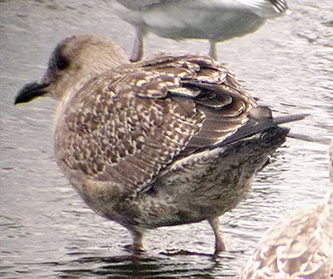
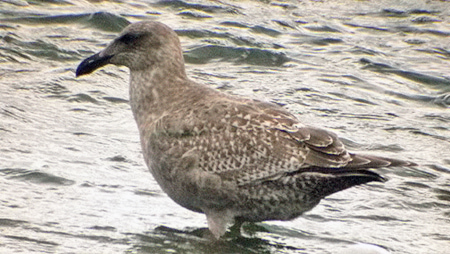
These very bulky Juveniles are distinctively dark brown (lacking grey tones), with pale fringes to the scapulars, dark spots coming through on the scapulars, and a faintly paler hind-neck collar (overall impression can recall a Skua species!).
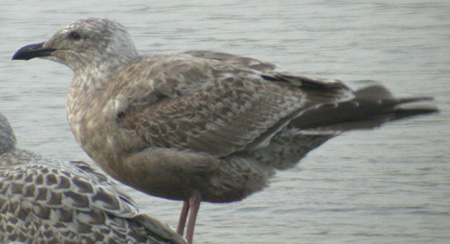
Compared to the Juveniles in Image 7 and 8 (photographed a week later), this individual already appears rather worn. Still separation from Juvenile and First-Winter Glaucous-winged is fairly straightforward, based on the pattern of the greater coverts, the strikingly brown plumage tones and the still dark primaries.
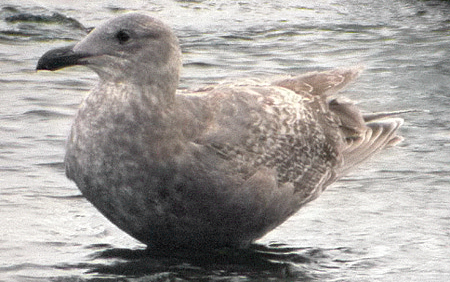
A very bulky individual, with a long forehead, heavy bill, small eye, and obvious grayish and oily plumage tones.
Apart from structural differences separation from darker Glaucous-winged when settled at this age can be based most reliably on the lack of obvious spotting or spangling in the coverts, the difference in primary coloration (blackish in Slaty-backed, grey-brown and oily-looking in Glaucous-winged); and in later Juveniles/early First-winters by the lack of an overall greyish wash to the mantle, breast sides and sometimes belly shown especially by Glaucous-wingeds at the same age. An additional feature is that the majority of Glaucous-winged (in East Asia at least) show very obvious dark on the shins and most especially in the webbing of the feet, and can look rather grey-legged, while the vast majority of Slaty-backed show pink or bright pink legs and 'clean' webbing at this and later ages.
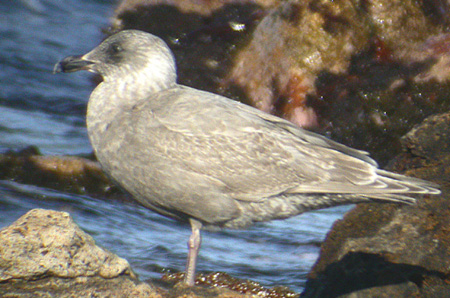
Although a rather slim and slender and plain individual, note the grayish tones overall, and most especially the very grayish leg colour (never yet noted by NM in Slaty-backed Gull).
In flight, as with adults, separation of Juveniles and fresh First-winters is somewhat easier. Juvenile Slaty-backed show a largely blackish or blackish-brown tail (often with some paler markings on the outer tail feathers) and a heavily mottled or marked brownish rump. This pattern is obviously different from all but probably less than 1% of the darkest Vega; and is clearly different from all juvenile and First-winter Glaucous-winged. Glaucous-winged show a rather grayer and uniform (sometimes pale-edged tail), with obvious white spotting across the rump and uppertail coverts. Additionally, Glaucous-winged lacks any obviously darker secondary bar and has fairly clean grayish-white outer primaries above (lacking contrast with the inner primaries), more obviously white and cleaner below. The upperwing of Slaty-backed Gull, by contrast, shows a fairly strong, dark secondary bar and a variably prominent pale blaze on the inner primaries (across p 1-4), with obvious dark subterminal tips (a feature shared more or less by Vega, by the genetically close Mongolian Gull, but not by taimyrensis) and rather darker outer primaries. On the underwing, Slaty-backed also shows a very distinctive pale blaze across the outer primaries offset, however, by dark tips to e.g. primaries 10-8.
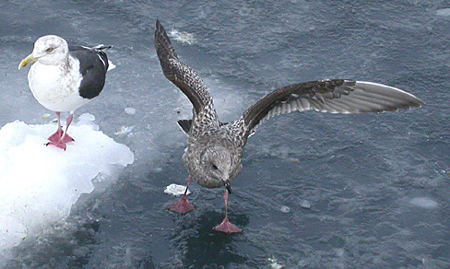
Note especially the dark tips to the outer primaries (10 to 6) and compare to Fig. 13.
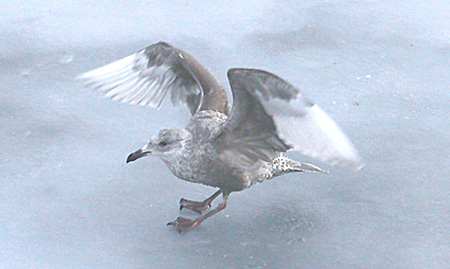
Note extreme contrast of white flight feathers and very dark underwing coverts and upperwing.
First -winters: extreme variation
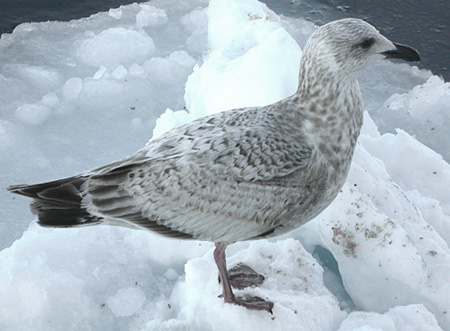
This rather worn individual (which showed a typical Slaty-backed Gull underwing pattern) also appears fairly typical at rest with its very bleached, white-looking greater coverts and heavily spotted neck sides. However, it also shows very strong grey and black patterning on the scapulars, much more reminiscent of Vega Gull. Is this an extreme Slaty-backed or could it be a hybrid Vega x Slaty-backed Gull?
Slaty-backed Gull First-winter plumage is variably developed from September onwards. Although the overall plumage tone remains brown, it at first reveals more contrast, with a few dark grayish-toned mantle feathers, and variably dark marks on the scapulars, ranging at extreme from small dark streaks to rarely (probably in rather less than 1%) barring of black and pale grey, strongly suggestive of First-winter Mongolian Gull. These uncommon individuals might either be extreme-plumaged Slaty-backeds, or possibly hybrids (with either Vega or even Mongolian Gull?). Additionally, there is a gradual paling of the head, chin, upper breast, and nape, with many birds showing a dark eye-patch, streaking on the crown and to the rear of the ear coverts, set off by an obviously pale hind-collar. Typically, First-winters also show blotchy spots and marks on the breast sides, and many retain darker brown patches on the lower belly, contrasting with a paler vent (which in turn often appears weakly barred or spotted). On the closed wing, the greater covert bar wears pale (sometimes appearing two-toned, darker above and paler below); the tertials lose most of their weak patterning; and the primaries bleach paler to become cream- or whitish-edged, often becoming paler than the tertials (so increasing some individuals' resemblance to Glaucous-winged Gull).
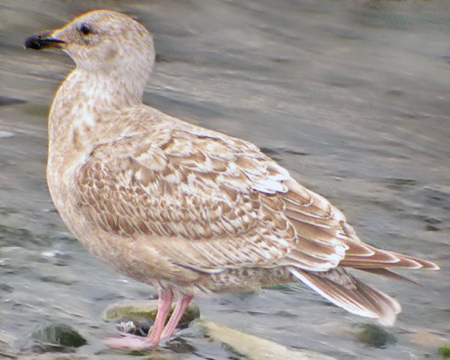
Short-legged and already heavily faded, with brownish primaries edged clearly white. Compare with Fig. 17.
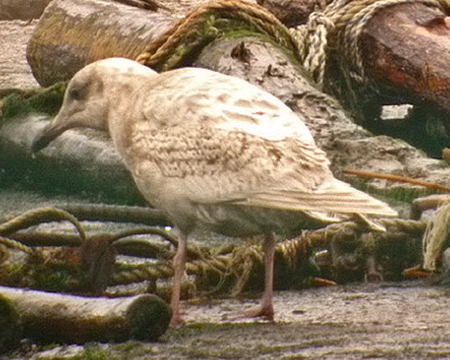
An extremely pale and worn individual, showing normal bare parts coloration (and also the distinctive “spread-leg” posture).
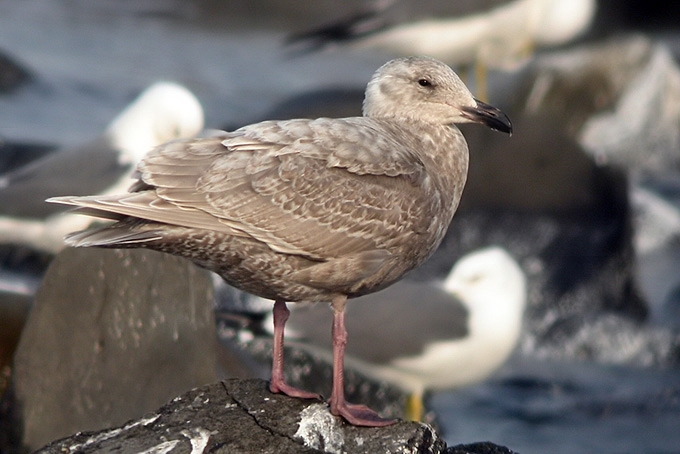
Note the spotted look to the undertail coverts and the upperwing coverts, and the grayish tones on the breast sides and belly.
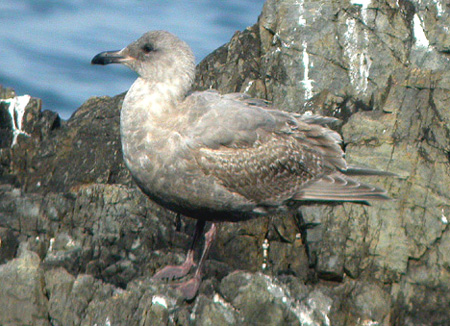
Note again the obvious grey wash, and the strikingly dark webs and shins.
As the winter progresses, so does this variation in the degree of bleaching and wear shown by First-winters, with some extreme individuals then showing very pale primaries, and very much reduced or muted plumage contrasts throughout (this especially by late February and March). Such individuals are ones most likely to be confused with Glaucous-winged Gull (or even Glaucous Gull at range), but can usually be separated at rest by their lack of pale covert spotting and lack of dull grey plumage tones. First-winter Glaucous-winged also typically show a dull grey, unmarked grey wash to the mantle, and a rather oily look to the dark eye-patch, which often extends up to the crown sides but not strongly across the ear coverts (thus positioned slightly differently to the equivalent patch in Slaty-backed). Many Glaucous-winged also show some fine head-streaking perceptible at close range at this time, but few show an obvious white forehead and chin, distinct, coarse streaking on the crown or blotchy look to the breast sides and on the belly shown by most Slaty-backeds. At the other extreme, many Slaty-backed First-winters remain rather dark and fresh-looking, still with blackish primaries, and are thus most likely to be overlooked as similarly-aged Vega. Identification of such individuals is usually possible based on structure, on similar plumage features used for separation of Juveniles (e.g. the patterning on the greater coverts and tertials), and on the generally plainer appearance of the mantle and scapulars in Slaty-backeds.
Identification in flight is (again) difficult, but usually more straightforward. The rump of First-winter Slaty-backeds becomes increasingly un-mottled white, the tail base shows increased contrast and paling, and the blaze on the inner primaries (with dark subterminal spots) also becomes increasingly apparent, contrasting with a typically blackish or dark secondary bar. Unlike Vega, Slaty-backed shows a slightly more diffusely dark outer wing and largely strong-whitish undersides to the primaries, which in Slaty-backed (and not Glaucous-winged) are then offset by obvious darker tips on several of the outer primaries.
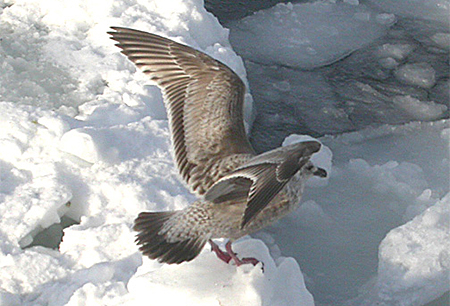
Upperwing similar to Vega Gull, but pale and dark on outer primaries rather more diffuse, with outer wing less solidly dark.
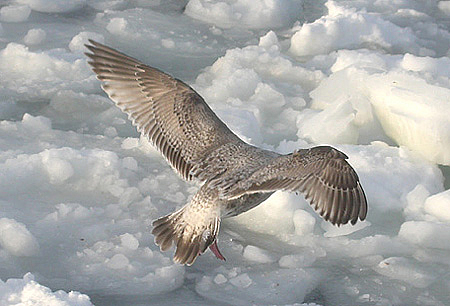
Note the very plain-looking greater coverts and the “venetian blind” look to the outer primaries.
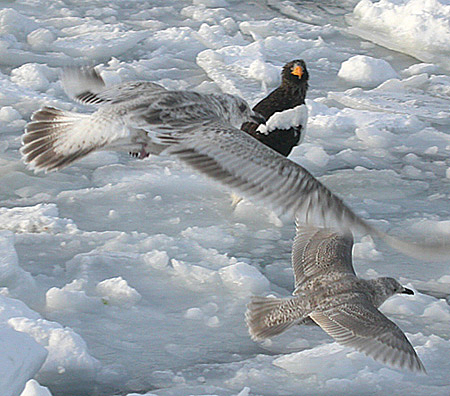
A very bleached individual, with white-looking greater coverts and a coarsely marked saddle. Note the difference in the rump pattern from Glaucous-winged Gull.
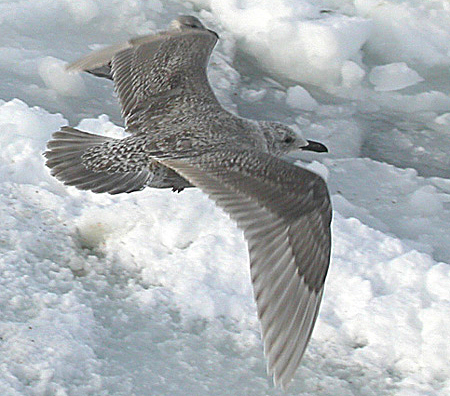
Note the much cleaner look, with obviously spotted rump, lack of obviously darker secondary bar and extremely plain tail.
Leg colour of First-winter Slaty-backed is typically clean and bright pink, with only a few retaining some obvious darker markings. Additionally, the bill begins to show pale, especially at the base and sometimes tip.
Late First-winter / (First-summer) / Second-summer
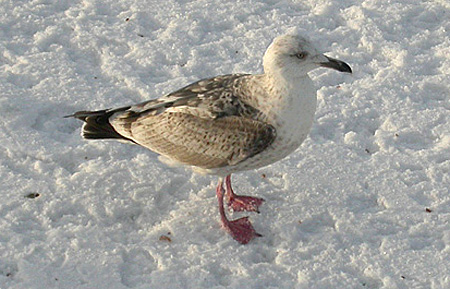
A distinctive species at this age, with a slate-grey mantle and already pale eyes.
By late February many birds show increased pale in the bill, and by April, sometimes an increasingly ragged or piebald appearance. Malling Olsen and Larsson (2003) considers that the eye becomes paler at this time, though typically, obviously pale eyes seem not to be shown before the Second-winter (from at least September through to March of the second and third calendar year). Second-winters show largely white heads and underparts, with variable streaking and mottling. Adult type feathers become intermixed in the mantle by late in the second winter, contrasting with the browner upperwings, and the often clean white rump. The tail remains largely blackish (with most Third-winters also still retaining a more variegated blackish tail band). The legs are pink, rarely a little dull-coloured, often very vivid, and the bill begins to show extensive yellowish-pink tones, with obvious dark subterminal markings. From this age, confusion is unlikely with other “pure” large gulls.
Variation in later plumages
Adult Slaty-backeds appear to show little variation beyond upperwing pattern and (more obviously) the extent of head-streaking or mottling in non-breeding birds. Throughout the winter period, occasional white-headed individuals can be found mixed in with flocks of almost hooded birds, with their number increasing rapidly from ca mid-February. Earlier personal observations of Slaty-backed Gulls in Japan (between 1990 and 1998) suggested the possibility of significant variation in adult saddle colour (with some much paler than others), a variation noted by several Japanese birders and also in Malling Olsen & Larsson (2003) - with some postulating that this might be a difference between northern and southern birds, and others suggesting it might be due to hybridization with Vega Gull. However, recent close scrutiny of flocks in both South Korea and Japan (e.g. in Hokkaido in February 2005) failed to reveal any significant variation in adult saddle coloration even in large single species flocks, beyond that expected due to angle and differences in light.
Hybrids: what to look for?
During 15 years of observation, NM has yet to encounter a single obvious or proven hybrid between Slaty-backed and another species, and has so far observed no mixed pairs or obvious displays between Slaty-backed Gull and other species. This is despite assertions in Malling Olsen and Larsson (2003) that Slaty-backed has been shown to hybridise with both Vega Gull (with hybrids “known from Koriak, Kamchatka and Japan”), and Glaucous-winged Gull (“small proportion of breeding birds along N and E coasts of Kamchatka and Commander Islands; reach S to Japan in winter”). If hybridization with these species occurs at all regularly, it therefore seems probable that (a) the resultant hybrid offspring are rather easy to overlook; and (b) that the features for picking up such hybrids are not well-known.
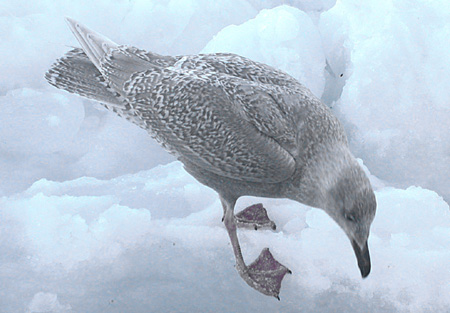
Note the all dark bill, the heavily patterned tail and the apparently nearly all-white primaries (with dark markings).
This seems somewhat in contrast to hybrids of some other large northern-breeding gulls in the region (which additionally show comparatively little typical variation as Juveniles or First-winters). In Korea, as elsewhere, for example, a small but significant percentage of Juvenile/First-winter Glaucous Gull show atypical bill patterning, and this patterning is considered by most observers a reliable indicator of hybrid origin (though it is typically unclear with what species). In the case of Glaucous-winged x Glaucous Gull hybrids too, some Juveniles/First-winters are fairly easy to identify - simply on the assumption that a bird showing a combination of an all dark bill with all white upper primaries must be such a hybrid. Hybrid offspring showing such distinctive combinations or features are surely rather easier to detect and claim confidently therefore than e.g. Slaty-backed x Vega or Slaty-backed x Glaucous-winged. As noted above, Juvenile and First-winter Slaty-backed Gull typically appear highly variable (much more so than either Glaucous or Glaucous-winged at a similar age), additionally typically sharing many key features with one or both of the other two species (e.g. bill patterning; extreme bleaching; pale edges to the closed primaries etc). This wide variation in Juvenile/First-winter Slaty-backed does seem to fall, however, within fairly predictable parameters (as outlined above), and moreover this apparent variability then declines with age so that “pure” adult Slaty-backed seem to show very little variation, especially when compared to many other large gull species found in the region.
Considering all of the above, it might seem appropriate to consider/suggest that any obviously atypical structural, plumage or bare parts' feature (or even unusual behavior?) detected in Slaty-backeds, especially in those individuals significantly outside of their normal range (but inside the range of e.g. Vega or Glaucous-winged Gull), might well be the result of hybridization. Considering too the species' restricted geographical range, its relatively short-range migration and its narrow habitat preferences (meaning that the vast majority of Slaty-backed Gull should at least be confined to coastal areas of the northern Pacific Ocean), it is clear that all extralimital individuals need to be as carefully assessed for hybrid features as is presently the case for most other better-known hybrid offspring (e.g. Glaucous x Glaucous-winged, Glaucous-winged x Western Larus occidentalis etc).
Based on the observation of many thousands of ‘typical’ Slaty-backed Gull within the normal range, the following, it is suggested, might indicate evidence of a hybrid origin:
Any obvious structural oddness (e.g. long-legged look, long primary extension in birds with fully grown tails etc);
Any odd bare parts coloration, most obviously dark eyes in adults (typical of the majority of non-breeding Vega) or any extensive black on the webbing of the feet and/or on the shins at any age (typical of Glaucous-winged in the region; shown very rarely if at all by Slaty-backed Gull);
Any grayish wash to the head or underparts in Juveniles or First-winters (typical of Glaucous-winged Gull);
Any atypical patterning on the scapulars and mantles of Juveniles or First-winters (including a Vega or Mongolian-like black barring on grey "background");
Any unusual head markings or unusually clean look to the underparts in e.g. Second-winters;
Any obviously paler mantle coloration in adult-types;
Any difference in the extent of or darkness of typically black parts of the primaries;
Any obviously atypical primary pattern.
It would be especially useful to discover from other observers examples of Slaty-backed Gulls considered to show such characters, and also to receive descriptions of proven hybrids with which to refine such criteria.
It is considered by the author that the following two individuals, both observed in Hokkaido in February 2005, were atypical enough to suggest the possibility of a hybrid origin.
Putative Hybrid One
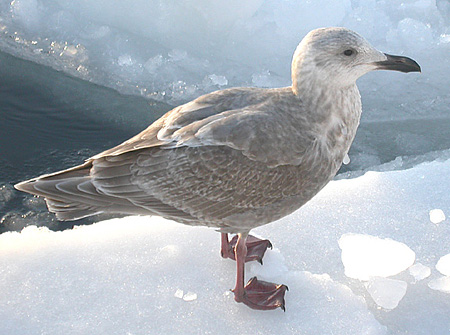
Closely resembling a rather typical First-winter Glaucous-winged Gull, this individual seemed to lack obvious grayish plumage tones in the field (though grey tones are apparent on the scapulars in the image), instead appearing washed brown and a little contrasty. Most of the plumage detail appears to match Glaucous-winged, including the fine mottling across many of the coverts, though the pale forehead, throat and hind-nape collar, the rather obviously streaked crown, and the more contrasting, weakly streaked hindneck and mantle all seem suggestive of Slaty-backed. It was not seen in flight.
Putative Hybrid Two
This Third-winter Slaty-backed Gull showed almost no contrast between the primaries and the saddle when settled (which in turn was paler than other Slaty-backeds in direct comparison), and rather limited black in the spread wing. Although it shows a weak “string of pearls” effect (perhaps typical of Third-winters), this pattern is not so very dissimilar to that shown by some Glaucous-winged Gull.
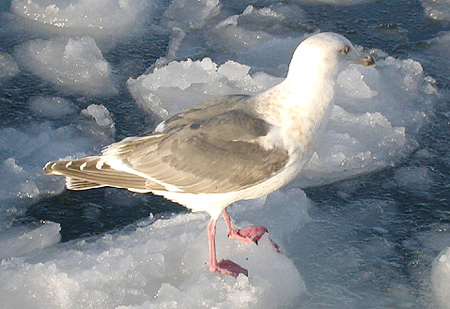
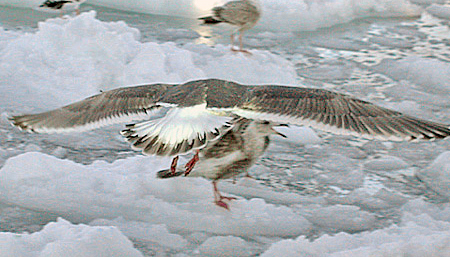
Summary
Largely confined to Far East Asia, the Slaty-backed Gull is a locally numerous non-breeding species in coastal South Korea (even more numerous in northern Japan). Especially following the publication of Malling Olsen & Larsson (2003), many of the identification criteria for the species have become rather better and more widely known. However, the very great range in appearance of especially First-winters, due to wear, moult and individual variation, can lead to misidentification and confusion, most especially with Vega Gull and some Glaucous-winged Gull, the latter a rather scarce winter visitor to South Korea.This online paper therefore describes a range of identification criteria. These include structure (short-legged, barrel-bodied and heavy-headed); plumage (most especially the pattern of the upperwing and underwing, as well as mantle coloration) and bare parts coloration (typically bright pink legs usually lacking the dark webbing and shins of most East Asian Glaucous-winged). Additionally, Malling Olsen and Larsson (2003) state that Slaty-backed Gull has been shown to hybridise with both Vega Gull and Glaucous-winged Gull in a narrow part of the breeding range. This note therefore proposes a list of possible features to use in the identification of possible hybrids.
As with all online articles on this site, we very much welcome any input and advice, in the understanding that: Through increased knowledge and observation can come increased opportunity for awareness and conservation.
Images were taken with a Nikon Coolpix by Nial Moores in Japan and South Korea and are copyright of Nial Moores/Birds Korea unless otherwise stated.
References:
- Olsen, K.M & H. Larsson (2003). Gulls of Europe, Asia and North America. Published by Helm.



